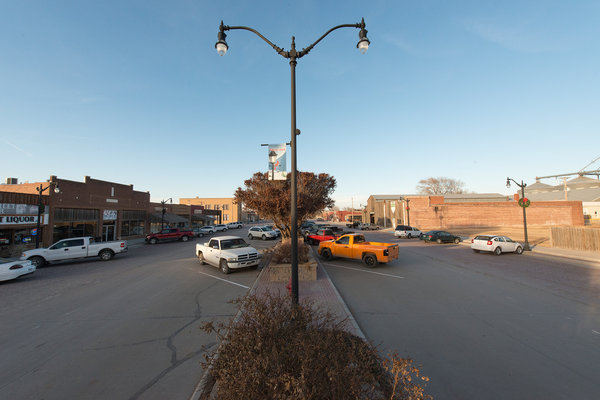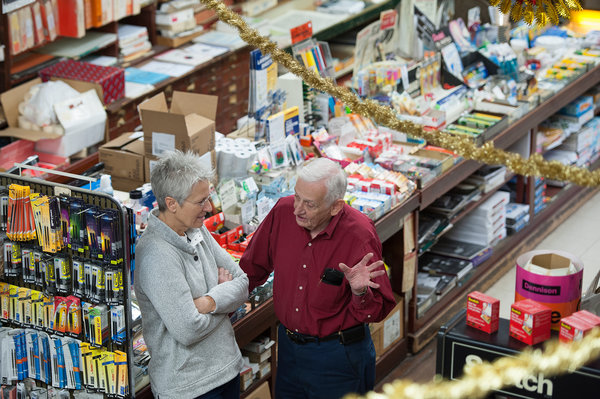A Kansas Town Rallies for a Modest Lifeline: A Local Grocery Store — NYT
A Kansas Town Rallies for a Modest Lifeline: A Local Grocery Store
By MITCH SMITH DEC. 29, 2014
The town of Plains, Kan., which has about 1,150 residents, lost a grocery store in 2001. Credit Craig Hacker for The New York Times
PLAINS, Kan. — Here in southwest Kansas, where small communities have struggled since the Dust Bowl to retain businesses and residents, a town’s viability is measured by what has not yet closed. Losing a post office is considered the kiss of death. Losing a school can be a terminal diagnosis.
But losing a grocery store, as Plains did in 2001, is a problem that, while not necessarily lethal, is most certainly cause for concern.
“A grocery store is the heart of the town,” said Jeanne Roberts, who is leading the effort to open a new shop. “In small towns, it’s the social gathering place. And when you don’t have that social gathering place and you’re going outside, then you don’t feel connected.”
Many people in Plains are fighting — against the odds, but with some notable success — to bring fresh groceries back to their one-square-mile city limits.
Supporters of the project believe a grocery store will serve as a catalyst for further development and an antidote to the demographic trends that have ravaged this part of the nation for decades.
Photo
Marci Penner, left, with Phil Anderson, the owner of Anderson Book and Office Supply in Newton, Kan., came up with the idea to create Kanstarter.com, a crowdfunding website. Credit Craig Hacker for The New York Times
As is typical for the region, this county’s population has fallen by roughly a third, to about 4,500, since peaking in the 1930 census.
No one here seems to be rooting against the grocery store, but some wonder how successful it would be. After all, Plains once had two places to buy food, and both went out of business.
“I just hope that if it does come, it’s supported,” said June Bender, the city clerk, who said she drives about 25 miles each way to much larger Liberal, Kan., and buys her food there. Ms. Bender rarely shopped in Plains when it had a grocery store, though she said “there’s good things” about having such a retailer in town.
Unlike some rural communities, Plains is not on the brink of death. It has about 1,150 residents, a figure that has stayed mostly steady for decades. There is a newly remodeled library, a busy post office and a high school a few miles outside of town.
Residents gather for coffee in the morning at Daylight Donuts, plan their evenings around youth choir concerts and speak highly of the Saturday night sirloin specials at the Plains Tavern.
“Plains is definitely a typical small town, with a small-town atmosphere,” said Elton Argo, the school district superintendent. “It’s a safe, very comfortable community.”
But there are also empty storefronts, residential streets with overgrown sidewalks, and many people who grew up here now raising their own families elsewhere. All that has some worried that Plains is at a tipping point: It can either thrive in its own right or fade into a bedroom community whose residents drive somewhere else to work, eat and shop.
Plains, like so many Midwestern towns, came of age in the early 20th century as America expanded westward and turned virgin prairie into endless farmland.
A 1916 book speaks rosily of the town’s population growth and new shops, but the fortunes of the region tumbled in the 1930s and ’40s, when topsoil blew away and agricultural productivity plummeted. Though conditions eventually improved, much of the western Great Plains never fully recovered.
Plains’s economy remains largely agricultural, but unlike a century ago, residents now must look beyond downtown to buy the essentials. Shoppers can purchase some food at a gas station in town, but a full selection of groceries requires a 14-mile drive to Meade, the county seat, or a longer one to Liberal, an economic center with about 20,000 residents, several meatpacking plants and large chain stores and restaurants.
In downtown Plains, retirees gathered earlier this month for a card game at the Young at Heart Senior Center. Credit Craig Hacker for The New York Times
Donald D. Stull, a professor of sociocultural anthropology at the University of Kansas who has studied the state’s communities, said it was not clear how many residents would choose to shop in Plains if given the choice, pointing to what he called the “Walmart effect.”
“People will drive 25 miles or 30 miles, where the local grocery is not going to be able to compete in terms of price or in terms of selection,” Professor Stull said. “That’s what they’re battling against. I’m not saying people won’t do it, but it’s an uphill battle.”
Ms. Roberts has been trying for six years to bring a grocery store back to Plains, and she believes there is renewed enthusiasm for shopping locally. With the help of other residents, she has formed a nonprofit foundation and lined up about $400,000 through tax credits, grants, donations and fund-raisers. With about $5,100 more, they will have enough money to finish buying the empty land on Grand Avenue where, one day soon, they hope to build.
To raise that money, Plains residents have turned to a new Kansas-centric crowdfunding website, Kanstarter.com, that was begun to help finance civic projects that could never be paid for with raffles at City Hall or fund-raising events at the county fair.
Though each place’s story is unique, there are many Kansas towns fighting the same battles as Plains. Marci Penner, who lives on a farm in central Kansas and once visited every town in the state to write a guidebook, came up with the idea for Kanstarter. She said the website, now in its pilot phase, could bring to fruition volunteer-led ideas that otherwise might never be financed.
“They don’t have a paid city manager, they don’t have a paid chamber of commerce,” Ms. Penner said, describing many small Kansas communities. “No one is paid to figure out how to sustain the town. Volunteers are left to figure out how to sustain the town.”
Plains is about one-third of the way to its fund-raising goal. Kanstarter has backers in state government who believe fully funded projects could lead to further development in rural communities. Earlier this year, the Kansas Department of Commerce awarded Ms. Penner’s foundation $200,000 in tax credits to help start and maintain the website.
But even if donors raise enough money to buy the property in Plains, organizers will still need roughly $1 million more to build, equip, stock and staff a store. It is a lofty goal, a fact acknowledged even by the project’s most optimistic supporters.
The grocery store’s boosters say they labor on because Plains’s limited shopping options affect more than just pantries.
Mr. Argo, the superintendent, said some candidates for teaching jobs have been scared off in part because of the lack of nearby food.
And Faye Coats, a retired farmworker who has lived in the town since the 1940s, said she thought downtown grocery shopping would be a boon to Plains, even though some of the women she played cards with were skeptical.
For Ms. Coats, traveling to another town to buy food might not be an option for much longer. “I’m going to be too old to drive pretty soon,” she said.
Susan Beachy contributed research from New York.


